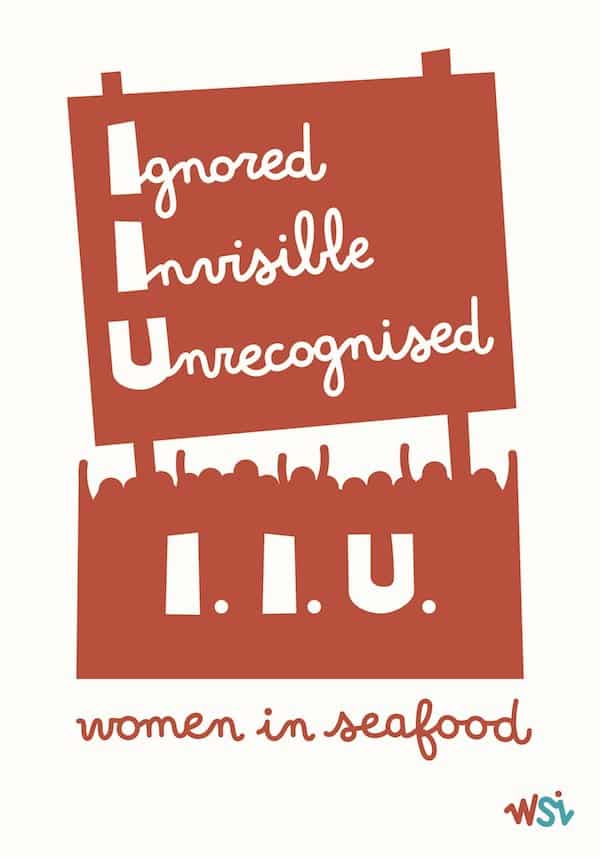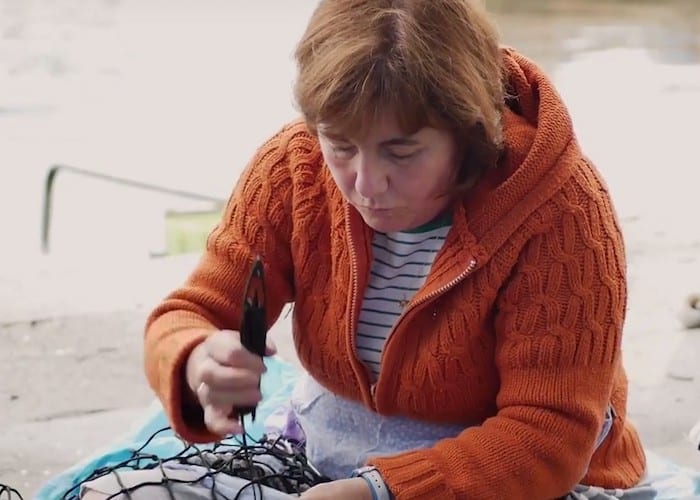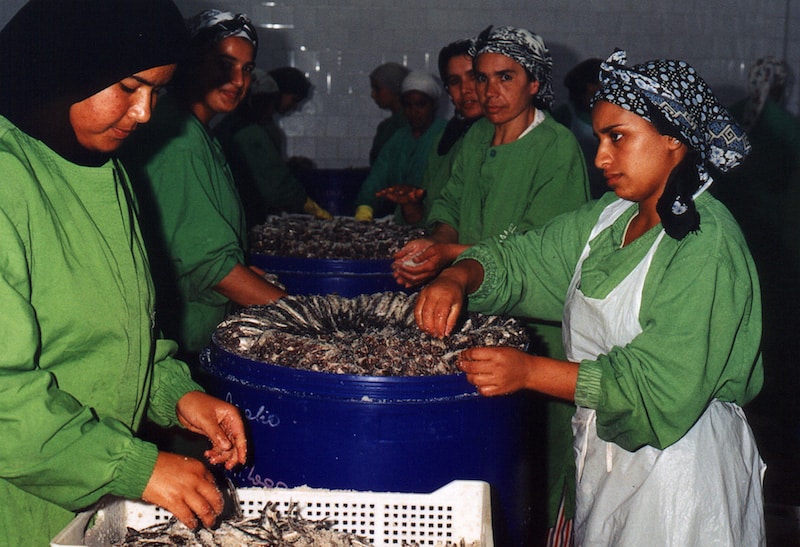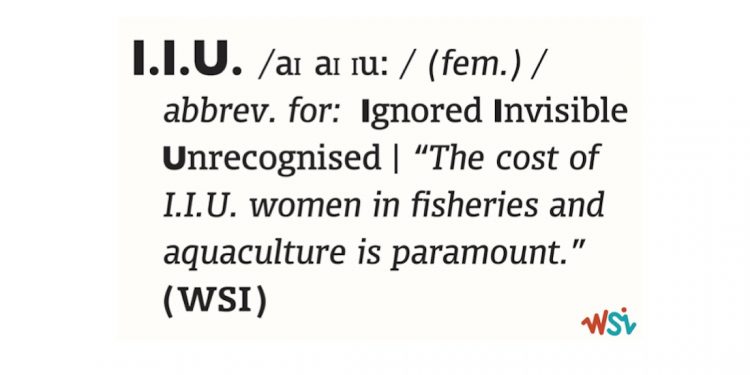On 8th March, International Women’s Day, Women in the Seafood Industry (WSI) sends an invitation to the seafood community to take on board that IIU is as serious as IUU.
Tremendous energy has gone into the fight against IUU (Illegal, Unreported and Unregulated) fishing, writes WSI President Marie Christine Monfort.

This issue costs between 10 to 20 billion dollars and is constantly present in fisheries discussions, conferences and articles. However, another phenomenon has equally disastrous consequences, reaching the proportions of a scourge: IIU, the Ignored, Invisible and Unrecognised women in the androcentric seafood industry.
This 8th March, International Women’s Day, we would like to invite our community, stakeholders and leaders to appropriate IIU with the same strength, concern, and budget resources that have been given to IUU.
The social, environmental and economic impacts of illegal and related fisheries are abysmal. In order to work against it, international communities have deployed massive energy and funds the past decade. To only mention a few actions – in 2001 the EU and FAO designed a plan of action to prevent, deter and eliminate IUU fishing, in 2002, the European Commission published its action plan for the eradication of IUU fishing, and the High Seas Task Force, comprising a group of fisheries ministers and international NGOs, was established to develop an action plan designed to combat IUU fishing on the high seas.
In the past twenty years, tens of conferences have focused on the impact of IUU and have developed many ways for eradicating it. The issue is has been embraced as so important, decisive and widespread that no one has any doubt about what the acronym IUU means. This became evidence and a rallying cry.

However, the fishing industry is suffering from other equally serious phenomena, but which have so far remained mostly in the shadows. Not only to avoid economic losses but also to achieve sustainable development in this sector, IIU – Ignored, Invisible and Unrecognised women in the seafood industry, must be addressed properly, especially if we consider that women represent half of the seafood worldwide workers.
The high cost of IIU
The Ignored, Invisible, and Unrecognised women in fisheries, as the words imply, have been hidden as though their work is confined only to the private domain of society, beyond the attention of decision makers. For decades numerous social scientists, but few of them economists, have revealed the evidence of the diverse and numerous areas of direct and collateral damage created by ignoring and discriminating against women in fisheries.
Indispensable but invisible
Women’s participation in the seafood sector is largely invisible, overlooked as if the viewer has a blind spot as far as women and their work is concerned, or hidden behind factory walls. As an example, the fishing effort made by women is not taken into account in fisheries management because they’ve been historically left out of accounting, despite numerous studies showing that they are working in mainstream fisheries or fishing but in different ecosystems from those typically used by men.

Not counting women in fishing statistics makes the diagnoses on which resource management rules are based erroneous. Yes, a little effort is being made to remedy the very poor state of sex-disaggregated statistics in the production stage, but this is one of the great challenges in the sector, needing much greater resources. Public policies and natural resource management tools are constructed in the absence of such data and ignoring, in addition, the level of women’s unpaid contributions. To add insult to injury, the lack of sex-disaggregated data is used as a pretext for not taking corrective actions.
Because women’s contributions are comfortably invisible, decision makers can comfortably consider this a non-issue.
Ignorance is not an irredeemable curse
Not only are women invisible, and many pretend they do not exist in the sector, but ignoring women’s knowledge and their contributions can result in inadvertently disadvantaging them when policy and management decisions are made. Who gets a licence, assistance, and access to opportunities? In private or public decision-making, outcomes could be wrong because women in this business have expertise and information that are not taken into consideration. For instance, in the context of climate change, the adaptation challenge urgently requires a proper diagnosis and the involvement of all players, including those so-far ignored, the women.
Ignorance of women’s knowledge and contributions is hard to crack but, normally, those in the sector are quick to learn, such as tackling IUU, new certification schemes and quality control procedures. We see opportunities to educate the seafood sector decision makers about what IIU costs and to stimulate gender inclusion, or even a restructuring of the priorities. The production of concrete and solid information on the subject is ongoing yet needs to be strengthened and accelerated. This valuable knowledge needs to be shared, sought out and used to illuminate public debates and private business practices.

Women are the half of this industry
The unpaid or underpaid work of women allows fishing activities by men, often on behalf of their households, to continue even when the activity is not profitable (mending nets, net making, administration, sales). The value of women’s labour should be considered as a hidden subsidy. As they often do work considered as “help”, women do not have the recognition that is needed for receiving a salary for the work done. Research has shown that on many occasions, wages become a source of bargaining power at the time of decision-making both in the private sphere and in the workplace. By being recognised through a salary, women gain in prestige, being better recognised and valued by their communities.
By unrecognised we mean women’s positions and roles along the entire seafood value chain, and also the issues that particularly afflict them, are not appreciated. Not only is their economic contribution little recognised but women can also often face unequal and unfavourable working conditions in fisheries and aquaculture.
Stereotypes and social norms, and often legislation, prevent women from accessing some jobs, for example, fisherwomen are not recognised as professionals in many countries and cannot become members of professional organisations. On the other hand, while high profile women suffer discrimination to access to boards or CEO’s positions, women in the labour intensive seafood processing industry, commonly suffer abusive treatment, violence, sexual harassment, poor and unsafe working conditions.
We call upon the responsible international organisations and national institutions, professional associations, trade unions, and private corporations to end IIU and address gender equality in a constructive way. All these institutions can encourage and facilitate the organisation of gender equality dialogue and action in the seafood industry.
Last November (2019), a key message from the FAO International Symposium on Sustainable Fisheries was that women must be made visible, included and their knowledge and value recognised. FAO and its member countries can seize on this outcome at its forthcoming Committee on Fisheries and Aquaculture 2020 Meeting and, for the first time ever, put gender equality on its agenda.









